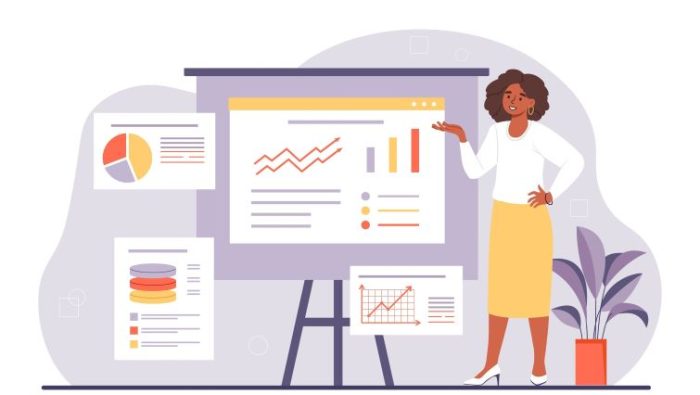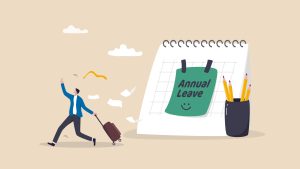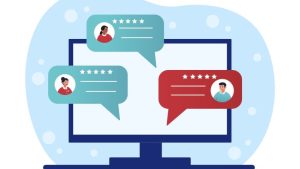Showing, Not Telling: 5 Ways Visual Aids Improve Any Meeting
 Publié le 29 February 2024
Publié le 29 February 2024
Boost attention and convey information effectively by knowing 5 ways visual aids improve any meeting.
If the abundance of “this could’ve been an email” memes on the internet is anything to go by, most people aren’t too fond of meetings.
A study by the Harvard Business Review found that the average employee spends around 31 hours a month in unproductive meetings, or nearly one entire working week. It gets worse the higher up the corporate ladder, with executives and managers clocking in nearly 23 hours of meetings each week, or more than half of the 40-hour workweek.
One reason (of many) why we can’t seem to escape the “meeting madness” is because we’re doing most of them wrong. Whether it’s a lack of structure, an unclear agenda, or even a speaker who has taken the floor for too long, we spend more time in meetings “telling” – talking about unfinished work, explaining problems, describing suggestions – instead of actually “showing” these things.
When done right, meetings can make workflows faster, better, and more effective. And one way we can take back control of meetings and ensure our times are used productively is with visual aids. There are 5 ways visual aids improve any meeting, let’s take a closer look.
The Power of “Showing”, Not “Telling”
If pictures are worth a thousand words, imagine how many hours of talking time they can save.
That’s exactly the power of visual communication. They keep participants engaged, make concepts easier to understand, and keep meetings from dragging on for too long by minimizing the need to over explain everything. Common visual aids include graphs and charts that display relevant data, roadmaps and infographics that break down strategies and processes, or images and illustrations that depict topics being discussed.
Less common – but no less effective – are interactive forms of visual communication like online whiteboards. These are especially handy for meetings involving a lot of brainstorming and free-flowing conversations, as they not only capture the ideas being discussed but also provide structure to an otherwise candid setup. Above all, they help keep attendees engaged in virtual meetings where attention spans are known to be more limited .
But this is only the tip of the iceberg. From simplifying complex data to keeping discussions on track and on time, there are several ways visuals can improve any meeting.
Simplify Information
Visual aids can break down large pieces of complex information into bite-sized, digestible chunks.
Imagine having to verbally explain the lifecycle of a wastewater pipe network to a roomful of politicians, journalists, and ordinary citizens. You would likely lose their attention within minutes from the technical jargon alone. Worst case scenario, you could even lose their support if they fail to understand the importance of your presentation.
Most of the time, your audience will not be as familiar with the topic as you are. Other times, they are only interested in a specific part of a wider subject. With the right visual aids, you can communicate information quickly and intuitively so that anyone who looks at the material will understand what is being shown.
Diagrams
Notable examples: flowcharts, organizational charts, Gantt Charts
Diagrams are visual communication tools that show the relationship between components. Instead of having cluttered blocks of information, they group together relevant details and use visual cues like lines, arrows, tables or borders, or even colors, to show order, establish connections, or delineate boundaries.
Charts
Notable examples: pie charts, bar graphs, line graphs
Charts capture quantitative data and present them in a recognizable manner. For instance, the year with the most sales is represented by the tallest bar, the demographics with the fewest members are shown as the smallest slice of the pie, the increase in profits is depicted as an upward diagonal line, and so on and so forth.
Improve Recall
If you’ve ever highlighted your notes or made flashcards to study, you know the importance of paring away excess information and leaving only what’s important. In meetings, attendees have to process several pieces of information in a short amount of time. By using visual aids to display only the key points of the discussion, we can make it easier for attendees to remember the important parts.
Take, for instance, a one-hour meeting about organizing the company year-end party. If the meeting organizer were to display a single slide or virtual whiteboard containing a list of the committee members and their respective tasks throughout those 60 minutes, the members would be more likely to remember their own assignments, maybe even their colleagues’, even if they barely pay attention during the discussion.
Some visual tools that can help attendees better remember meeting points are:
Images
Compared to blocks of text, pictures are not only easier to look at, but they’re also easier to remember. Multiple studies over the decades have shown that the human brain deciphers and encodes visual elements faster, better, and more easily than text. Of course, it’s important to use relevant images to accompany your text; otherwise, it could end up distracting or confusing the audience.
Infographics
Infographics are a stylistic presentation of key points, which use visual designs as much as texts. They’re great for providing a high-level overview or short, digestible details about a topic. More importantly, the use of creative elements like colors, illustrations, and images makes infographics nicer to look at than just plain text.
Engage attention
Our attention spans are getting shorter. We are less engaged in meetings. When we talk during meetings, we’re only engaging one sense at a time – more so if it’s a virtual session with cameras off. And when we talk to specific people, we’re effectively cutting out everyone else from the conversation, even if they’re still there.
To combat this, we also need to engage people’s other senses. Support verbal discussions with visual cues that the audience can follow. For example, if you’re discussing an organizational restructuring with the team, show a comparison of the old structure versus the new one, making sure to highlight (with a different color, an outline, etc.) the point relevant to them, i.e., where their roles will fall.
In addition to the visual aids mentioned above, other tools you can use to engage your audiences are:
Interactivity
Nothing hampers audience engagement quite like a one-way communication line. Adding interactive elements to meetings ensures that everyone has a chance to participate, especially if the meeting is online. A tool like an online whiteboard not only displays visual aids like a normal meeting presentation (e.g., graphs, charts, tables, etc.) but also lets attendees contribute directly to the conversation.
Videos and animated images
If we want to keep the conversation moving, dynamic visual aids are the way to go. Adding videos and animated GIFs can elevate an otherwise flat and static presentation. Short clips can provide context and save the presenters the need to explain everything themselves. While animations can break the monotony of text blocks and make presentations a little more interesting.
Boost Efficiency
Remember what we said about pictures and how the brain processes them? When used correctly, visual aids save time, effort, and resources. They reduce the need for explanation, as viewers can glean what they need by looking at the material. They make it easier for readers to follow along and stay engaged by distributing the information across different senses. They help keep both speakers and listeners on the same page with a physical reference of the current discussion point, as well as provide overall structure to the meeting.
In short, people can actually have a productive session. Audiences learn vital and relevant information. Speakers cover all the topics they need to discuss. And meetings stay on track and on time without diverting to other discussions.
Having visual cues throughout a session can help move things forward and prevent topics from dragging on for too long.
Timer
What better way to keep track of the time than by having an actual timer throughout the presentation? This is especially useful during long meetings, or for sessions with multiple speakers. However, as timers can be distracting for both speakers and listeners, it’s best to keep it in an unobtrusive location like the side of the screen, or only show up at certain marks like the half-hour or top-of-the-hour points.
Agenda
An agenda structures meetings and sets expectations of the topics to be covered. Meeting organizers can send out the agenda to attendees ahead of the meeting, or print physical copies and distribute them during the session. Having a tangible reference to the flow of the meeting will help speakers and attendees stay on track and minimize unrelated tangents.
Elevate communication
One of the biggest challenges of meetings is that they can feel like a one-way street. Instead of multiple people contributing to the conversation, it’s more likely that one or two people have the floor, while the rest are passive listeners. While visual aids are no substitute for an effective organizer and a well-structured agenda, they can, at the very least, keep things interesting.
Visual aids can elevate the quality of a meeting by capturing the important points discussed, making it easier for attendees to follow along and remember key topics, and even prevent the session from being too monotonous or convoluted. Engaged participants who actively listen during the discussion are likely to have fewer questions or concerns, reducing the chances of miscommunication and minimizing the need for follow-up discussions – ergo, even more meetings.
Visual materials can help ensure that everyone stays on the same page even after the meeting.
Handouts
Printed or digital handouts recapping the key points and reminders from the session are extremely helpful for attendees, especially if several topics were covered. These handouts can range from simple bullet points to comprehensive minutes of the meeting document.
Beat the Meeting Fatigue
Visual aids can do wonders for the quality of any meetings. Whether you’re presenting an important proposal to the board of directors, or hosting a standard, weekly stand-up meeting with your small team to review business goals, using the right visual aids to support your verbal conversations can go a long way in keeping your attendees engaged, actively listening, and contributing meaningfully to the discussion.
There are 5 ways visual aids improve any meeting. Simplify complex topics with graphs, charts, and diagrams. Improve information recall with eye-catching photos and infographics. Engage your audience’s attention with dynamic videos and interactive whiteboards. Boost the efficiency of your sessions with visual guides like a timer and visible agenda. You can also elevate communications in and out of the meeting with supporting materials like handouts.
Since not all meetings can be emails, a good host and organizer ensures that these discussions provide value for their attendees’ time, effort, and participation. Adding visual aids to these sessions is a step in the right direction toward making meetings more productive, impactful, and time-worthy.







